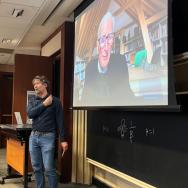The Bulletin of the Atomic Scientists announced on Jan. 23 that the hands of the Doomsday Clock will remain at 90 seconds to midnight—the closest it has ever been to apocalypse.
Every year, the Bulletin determines how much metaphorical time we have to avert catastrophe for humankind. Over the past 75 years, the hands of the clock have moved according to whether steps were taken to address threats that could end human civilization on Earth, including climate change and nuclear war.
In 2023, the Bulletin set the hands of the clock at a minute and a half to midnight—closer than it had ever been before, including during the Cold War. This year, the organization determined that not enough progress has been made to move the hands back.
Rachel Bronson, president and CEO of the Bulletin, said the move is “not an indication that the world is stable. Quite the opposite. It’s urgent for governments and communities around the world to act.”
The Bulletin of the Atomic Scientists was created by a group of concerned Manhattan Project scientists, many based at the University of Chicago, shortly after the atomic bombings of Hiroshima and Nagasaki. In 1947, artist and Bulletin member Martyl Langsdorf created the iconic Doomsday Clock to signal how close humanity was to self-destruction.
Today, the Doomsday Clock is located at the Bulletin offices in the Keller Center, home to the University of Chicago Harris School of Public Policy. Multiple UChicago faculty members have served on its boards over the years; currently, University of Chicago Prof. Daniel Holz is chair of the Science and Security Board that sets the hands of the clock every year, and Prof. Robert Rosner sits on the Board of Sponsors.
In their 2024 decision, the Bulletin cited the continuing war in Ukraine and Russia’s suspension of its participation in arms agreements, the war in Gaza, and the fact that 2023 was the hottest year on record. They also noted the growth of AI as a disruptive technology with potential for magnifying corruption and disinformation, though it may not yet be categorizable as an existential threat.
They also noted, however, increased investment in renewable energy as a positive step. The Bulletin has always emphasized that the clock is not intended to make people fearful, but rather to spur them to action. The full statement lists a number of actions needed to make the world safer, and urges people to press their governments for action.

